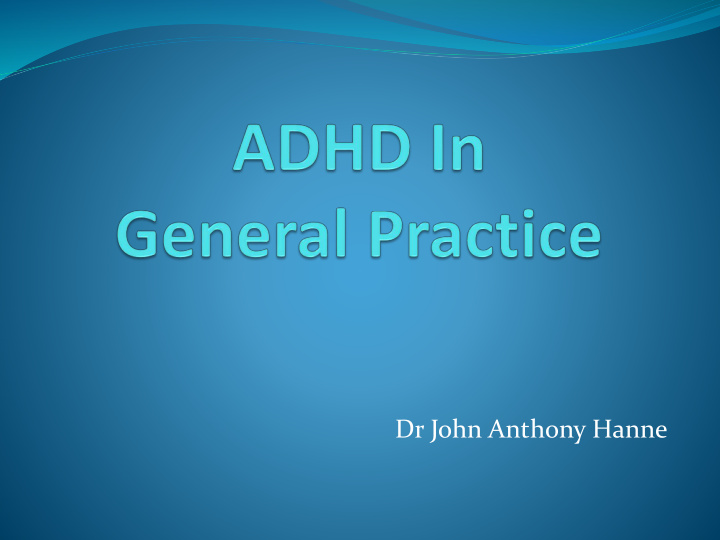



Dr John Anthony Hanne
Gypsy?
“But you told me to behave… You didn’t say how !”
Who did Dennis get it from? What happens to Dennis as he enters adulthood?
Did you know? Approx. 2/3 of ADHD kids still need help in adulthood
Risks of ADHD in Adulthood 22 x more likely to be incarcerated 4 x more likely to be involved in motor vehicle accident 2 x more likely to be addicted to alcohol/other substances
Risks of ADHD in Adulthood 2 x more likely to be involved in relationship breakdown, job instability (e.g. dismissed, disciplined, quit) Less likely to finish university Elevated risk of suicide, self harm
Abundant Neurological Evidence PET MRI fMRI Genetic studies
Common Co-morbidities Depression Anxiety OCD Eating Disorders Specific Learning Disorders Substance Abuse
Common Co-morbidities Frustration Sense of Failure Depression
Learning Disorders ADHD – Dyslexia, Dyscalculia Dysgraphia
When ADHD is treated: Improvements in Depression Improvements in OCD
Ask yourself... Is ADHD primarily a GP condition? What role should specialists play?
Fidgety Phil Who Couldn’t Sit Still Dr Heinrich Hoffmann publishes a fictional tale based on his work with hyperactive children, published 1845
Prevalence Approx. 5% of population regardless of culture, ethnicity In NZ less than 20% of ADHD is being managed Compare that with Diabetes
Making the Diagnosis Questionnaires Ratings scales School reports Family/loved ones/close friends Let them tell their story! Allow enough time
ADHD - A Spectrum Condition Ranging from the hyperactive/impulsive extreme to the quiet dreamer Inattention/distractibility is key
Modifying Factors Personality type Intelligence Home Life Significant Life Choices (e.g. choice of study, career, partner)
Gender Ratio Equal ratio in adulthood …But diagnosed 5:1 male/female in childhood
Ready! Fire! Aim…?
Useful Tests TOVA (Test of Variable Attention) Short term memory exercises Raven IQ Test
Managing ADHD Lifestyle 1. Diet/Exercise 2. Education 3. Support 4. Medication? 5.
Medication Ritalin or dexamphetamine? Ritalin dose varies Adderall not licensed Strattera?
Job done? Regular follow up Coaching – best results take 1-2 years
The Results Are Incredibly Rewarding “It was like a fog suddenly lifted” “These days I actually remember where I’m supposed to be” “No matter how hard I tried I was always late coz I would forget where I put my keys, my wallet, my phone…or I’d get busy with stuff that was more interesting and then just completely tune out.” “Someone would be talking about something real important like how their father had died and all I would hear was ‘blah, blah, blah’. Then I’d cut in and just completely change the subject. Then I’d feel awful about it, but what can you do? You know?” “My life was like a car out of control. There were yellow and red traffic lights warning me to stop before I acted, but I could never put the brakes on. I just sped on through. My brain just acted like there were green lights all the time!”
The Bogey-Man of Substance Abuse
For more information on ADHD contact: jahanne@clear.net.nz
Recommend
More recommend